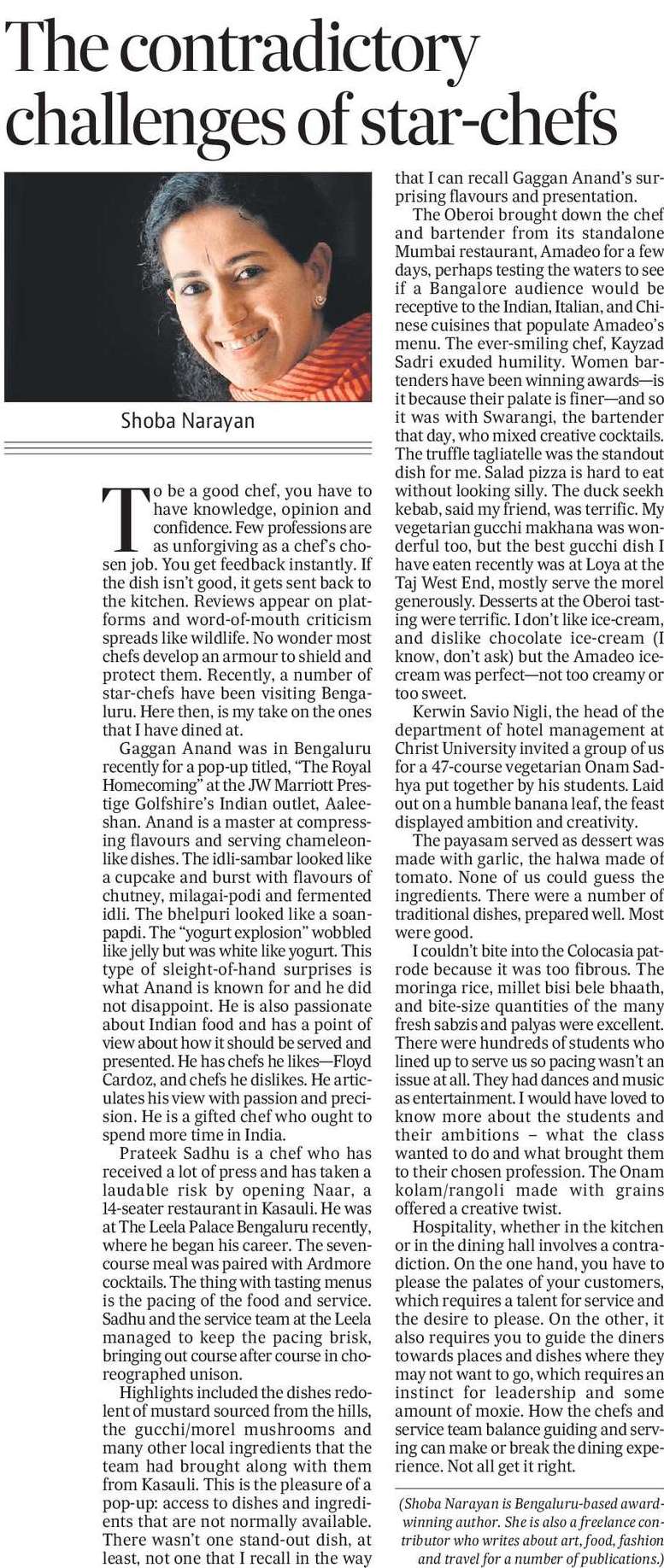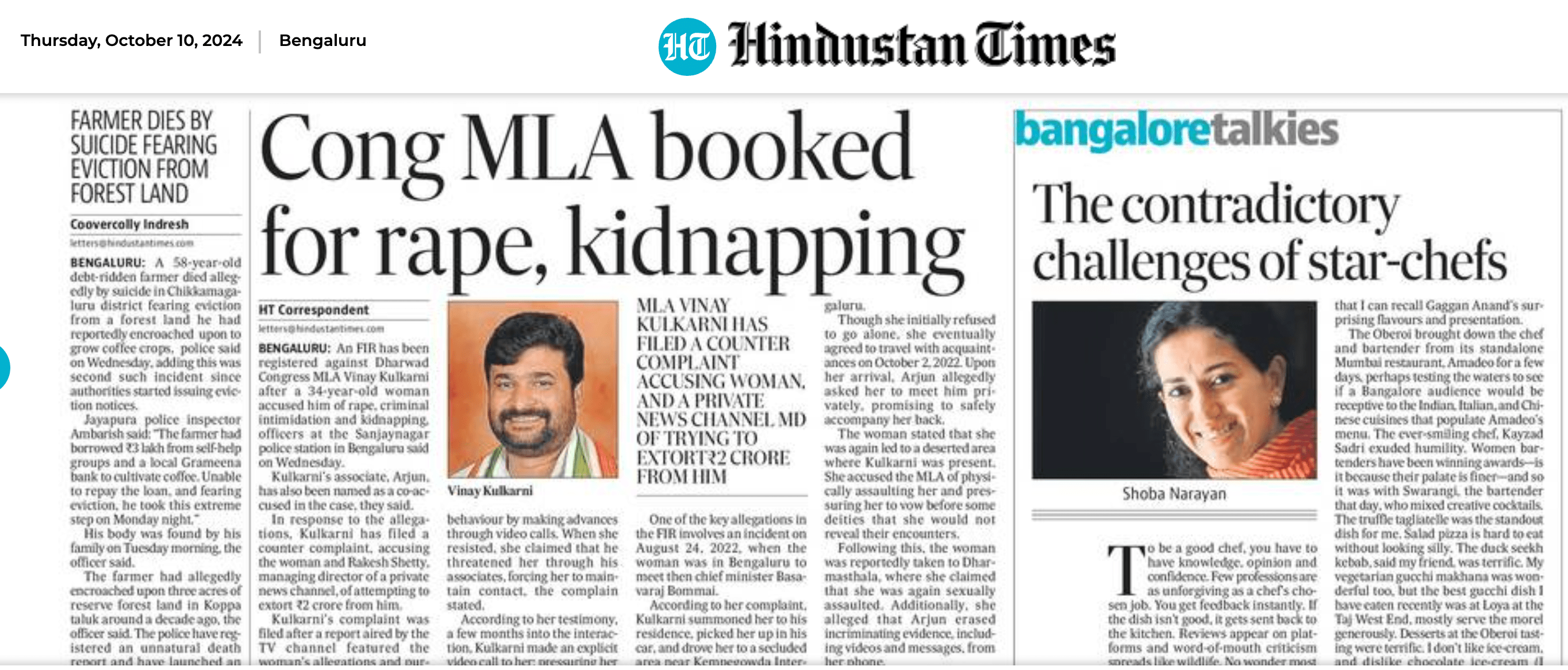To be a good chef, you have to have knowledge, opinion and confidence. Few professions are as unforgiving as a chef’s chosen job. You get feedback instantly. If the dish isn’t good, it gets sent back to the kitchen. Reviews appear on platforms and word-of-mouth criticism spreads like wildlife. No wonder most chefs develop an armour to shield and protect them. Recently, a number of star-chefs have been visiting Bengaluru. Here then, is my take on the ones that I have dined at.
Gaggan Anand was in Bengaluru recently for a pop-up titled, “The Royal Homecoming” at the JW Marriott Prestige Golfshire’s Indian outlet, Aaleeshan. Anand is a master at compressing flavours and serving chameleon-like dishes. The idli-sambar looked like a cupcake and burst with flavours of chutney, milagai-podi and fermented idli. The bhelpuri looked like a soan-papdi. The “yogurt explosion” wobbled like jelly but was white like yogurt. This type of sleight-of-hand surprises is what Anand is known for and he did not disappoint. He is also passionate about Indian food and has a point of view about how it should be served and presented. He has chefs he likes—Floyd Cardoz, and chefs he dislikes. He articulates his view with passion and precision. He is a gifted chef who ought to spend more time in India.
Prateek Sadhu is a chef who has received a lot of press and has taken a laudable risk by opening Naar, a 14-seater restaurant in Kasauli. He was at The Leela Palace Bengaluru recently, where he began his career. The seven-course meal was paired with Ardmore cocktails. The thing with tasting menus is the pacing of the food and service. Sadhu and the service team at the Leela managed to keep the pacing brisk, bringing out course after course in choreographed unison.
Highlights included the dishes redolent of mustard sourced from the hills, the gucchi/morel mushrooms and many other local ingredients that the team had brought along with them from Kasauli. This is the pleasure of a pop-up: access to dishes and ingredients that are not normally available. There wasn’t one stand-out dish, at least, not one that I recall in the way that I can recall Gaggan Anand’s surprising flavours and presentation.
The Oberoi brought down the chef and bartender from its standalone Mumbai restaurant, Amadeo for a few days, perhaps testing the waters to see if a Bangalore audience would be receptive to the Indian, Italian, and Chinese cuisines that populate Amadeo’s menu. The ever-smiling chef, Kayzad Sadri exuded humility. Women bartenders have been winning awards—is it because their palate is finer—and so it was with Swarangi, the bartender that day, who mixed creative cocktails. The truffle tagliatelle was the standout dish for me. Salad pizza is hard to eat without looking silly. The duck seekh kebab, said my friend, was terrific. My vegetarian gucchi makhana was wonderful too, but the best gucchi dish I have eaten recently was at Loya at the Taj West End, mostly serve the morel generously. Desserts at the Oberoi tasting were terrific. I don’t like ice-cream, and dislike chocolate ice-cream (I know, don’t ask) but the Amadeo ice-cream was perfect—not too creamy or too sweet.
Kerwin Savio Nigli, the head of the department of hotel management at Christ University invited a group of us for a 47-course vegetarian Onam Sadhya put together by his students. Laid out on a humble banana leaf, the feast displayed ambition and creativity.
The payasam served as dessert was made with garlic, the halwa made of tomato. None of us could guess the ingredients. There were a number of traditional dishes, prepared well. Most were good.
I couldn’t bite into the Colocasia patrode because it was too fibrous. The moringa rice, millet bisi bele bhaath, and bite-size quantities of the many fresh sabzis and palyas were excellent. There were hundreds of students who lined up to serve us so pacing wasn’t an issue at all. They had dances and music as entertainment. I would have loved to know more about the students and their ambitions – what the class wanted to do and what brought them to their chosen profession. The Onam kolam/rangoli made with grains offered a creative twist.
Hospitality, whether in the kitchen or in the dining hall involves a contradiction. On the one hand, you have to please the palates of your customers, which requires a talent for service and the desire to please. On the other, it also requires you to guide the diners towards places and dishes where they may not want to go, which requires an instinct for leadership and some amount of moxie. How the chefs and service team balance guiding and serving can make or break the dining experience. Not all get it right.
Shoba Narayan is Bangalore-based award-winning author. She is also a freelance contributor who writes about art, food, fashion and travel for a number of publications.



-k4lD-U204025897261YmH-250x250%40HT-Web.jpg)



Leave A Comment